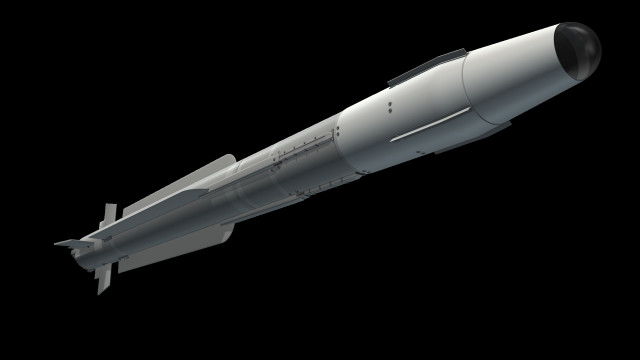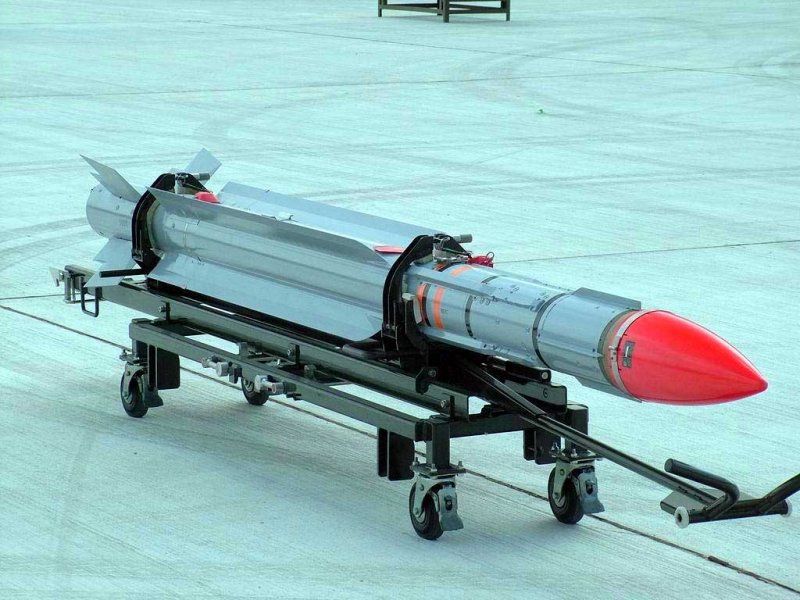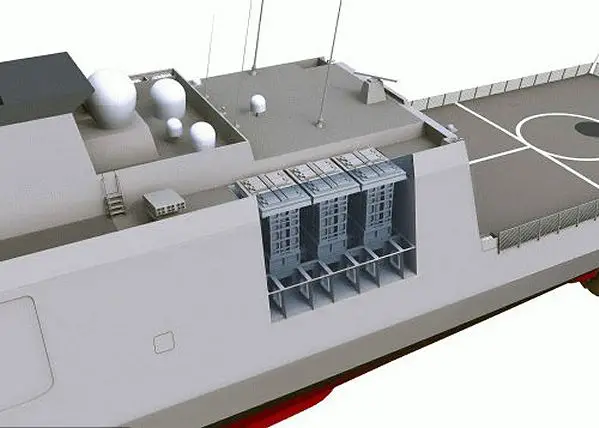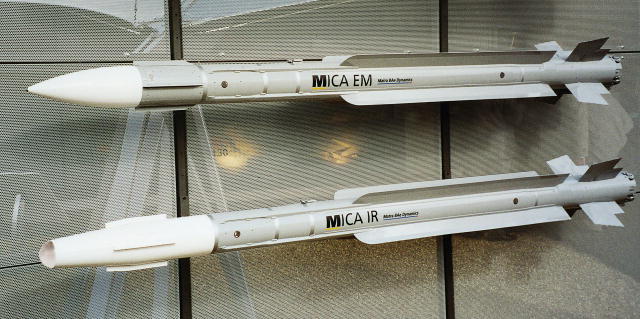The MBDA vertical launch Mica short-range air defence system, VL Mica SHORAD, is an anti-air multi-target, all weather, fire-and-forget short and medium-range missile system. It is intended for use both by air platforms as individual missiles as well as ground units and ships, which can be equipped with the rapid fire MICA Vertical Launch System. It is fitted with a thrust vector control (TVC) system. The modular VL Mica system includes a tactical operations centre with up to four multi-round missile launchers. MBDA displayed the system for the first time in February 2000 at the Asian Aerospace 2000 Show in Singapore. The first vertical launch of the VL Mica missile took place in 2001 at the Centre d'Essais des Landes range in France.
It was developed from 1982 onward by Matra. The first trials occurred in 1991, and the missile was commissioned in 1996 to equip the Rafale and Mirage 2000. It is a replacement for both the Super 530, in the interception role, and the Magic II, in the dogfighting role.
In December 2005, MBDA was awarded a contract for the development of the system (previously a private venture) for all three French forces. VL Mica would be used to protect air bases for the Air Force, deployed forces for the Army and as point defence for major surface vessels for the Navy.
On 11 June 2007, a MICA launched from a Rafale successfully demonstrated its over-the-shoulder capability by destroying a target behind the launch aircraft for the first time in aviation history. The target was designated by another aircraft and coordinates were transmitted by Link 16.
The land-based missile system is mounted on a 5t truck. The system gives 360° coverage against fixed and rotary wing aircraft, unmanned air vehicles and air launched missiles.
Characteristics
There are two MICA variants; MICA RF has an active radar homing seeker and MICA IR has an imaging infra-red homing seeker. Both seekers are designed to filter out counter-measures such as chaff and decoy flares. A thrust vector control unit fitted to the rocket motor increases the missile’s agility. The missile is capable of lock-on after launch (LOAL) which means it is capable of engaging targets outside its seeker’s at-launch acquisition range. Mounted on the Rafale, the MICA IR can provide IR imagery to the central data processing system, thus acting as an extra sensor.
MICA can also be employed as a short-range surface-to-air missile. It is available in a ground-based version, VL MICA, fired from a truck-mounted box launcher, and a naval version, VL MICA-M, fired from a ship-fitted vertical launch system.On October 23, 2008, 15:30, at CELM, Biscarosse (Landes), a VL MICA missile successfully performed the last of its 14 test firings meaning it is now ready for mass production. The target drone was flying at low level, over the sea, 12 km away; despite this distance, MICA, equipped with an active radar seeker, locked on the target and shot it down.
Corvettes too small to have the big and costly Aster missile system are the most likely customers for the VL MICA-M, which offers similar capability as the Aster 15 but without its booster and PIF-PAF vectorial control.
While the VL MICA has an advertised range of 20 km, aerodynamic performance is significantly degraded at those ranges. From 0 to 7 km MICA has maneuverability of 50g, however by 12 km this is reduced to 30g as energy is lost.
The VL Mica SHORAD system is fire and forget and has all-weather, day and night capability to carry out simultaneous engagement of multiple targets.
VL Mica uses the air-to-air Mica missile that has been ordered by the French Air Force and Navy for Rafale and Mirage 2000 fighter aircraft and by the air forces of UAE, Greece and Taiwan for the Mirage 2000.
Mica vertical launch missile
The 112kg vertical launch missile is built in two versions, an active radar Mica RF with a pointed nose cone and a passive infrared imaging Mica IR with a rounded nose. Mica RF has been in production since 1996 and the Mica IR since 2000. Both sensors are robust against jamming. The slim body structure of the missile is identical to that of the original air-to-air Mica. The four L-shaped guidance fins installed at the rear of the body are movable.
Mica RF is equipped with a programmable J-band, pulse Doppler AD4A radar seeker with a pointed ceramic radome at the nose.
The radar seeker, supplied by Thales and Alenia Marconi Systems, operates at 10GHz to 20GHz. The seeker is of proven design and performance and is also installed in the Aster missile.
The Mica IR uses a Sagem passive dual-band imaging infrared seeker with a rounded infrared-transparent glass dome. The seeker uses closed cycle cooling. The guidance compartment is equipped with a strap down inertial reference system.
The directed splinter fragmentation high explosive blast warhead, weighing 12kg, is supplied by TDA Armements, a joint venture formed by Thales and EADS. The warhead is located behind the seeker and is fitted with an impact fuse and a radar proximity fuse.
A butalite solid propellant booster and sustainer motor, supplied by Protac, is located in the mid-section of the missile. Four slotted vanes on a circular plate over the rear exhaust are efflux deflection vanes which provide thrust vector control. The movable L-shaped guidance fins and the efflux deflection vanes give the missile manoeuvrability up to 50g.
Mica tactical operations centre
The Mica tactical operations centre has up to four truck-mounted multi-round launchers. The launch assembly is installed on a 5t truck and can be loaded with any combination of four Mica RF and Mica IR missiles. The vertical launch system is based on the vertical launch technology developed by BAE Systems for the Seawolf naval air defence missile.
A distributed architecture system allows target data to be downloaded from a variety of sensors so the VL Mica system can operate alone or integrated into a large widely distributed air defence network.
Operation
The pre-launch target designation is downloaded into the missile. The target designation data can be supplied by a radar or optronic surveillance system.
The missile is launched vertically using thrust vector control. The flight is controlled by the programmable strap down inertial mid course guidance system and then by the terminal homing seeker.
The missile's butalite solid propellant booster and sustainer motor gives a maximum speed of greater than Mach 3. The maximum target range is 10,000m and 9,000m altitude. The launch rate between firings is two seconds.
 |
| An air-launched MICA on a Dassault Rafale |
MICA RF
MICA EM
MICA IR
VL MICA RF
VL MICA IR
VL MICA-M RF
VL MICA-M IR
Specifications
Weight 112 kg
Length 3.1 m
Diameter 160 mm
Wing span 480 mm
Warhead 12 kg warhead
Detonation mechanism
Proximity or direct impact
Engine Solid-propellant rocket motor
Operational range
Air-launched: 0.2–50 km
Vertical-launched: 1–20 km
Flight altitude
Vertical-launched: 0–11 km
Speed Air-launched: Mach 4
Vertical-launched: Mach 3
Guidance system :
MICA-EM: Active radar homing
MICA-IR: Infrared homing
Launch platform :
Surface ship
Ground batteries
Dassault Rafale
Mirage 2000
F-16E Block 60





